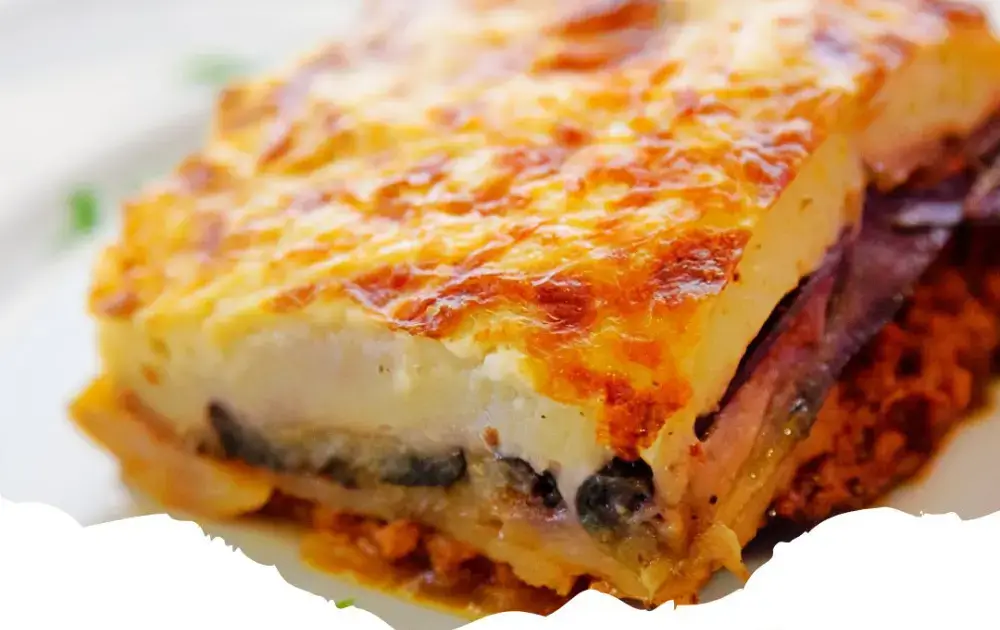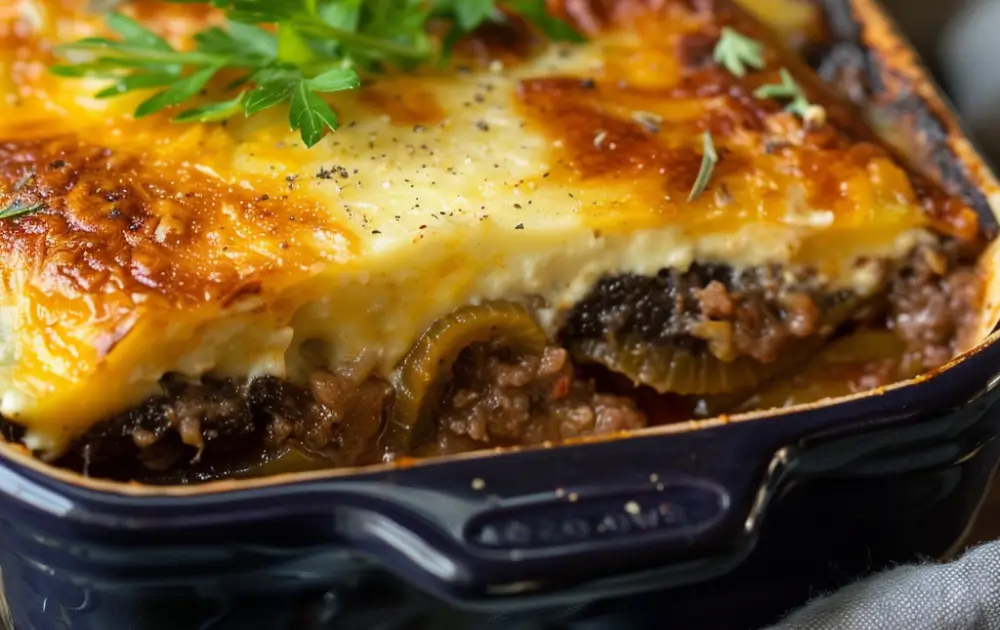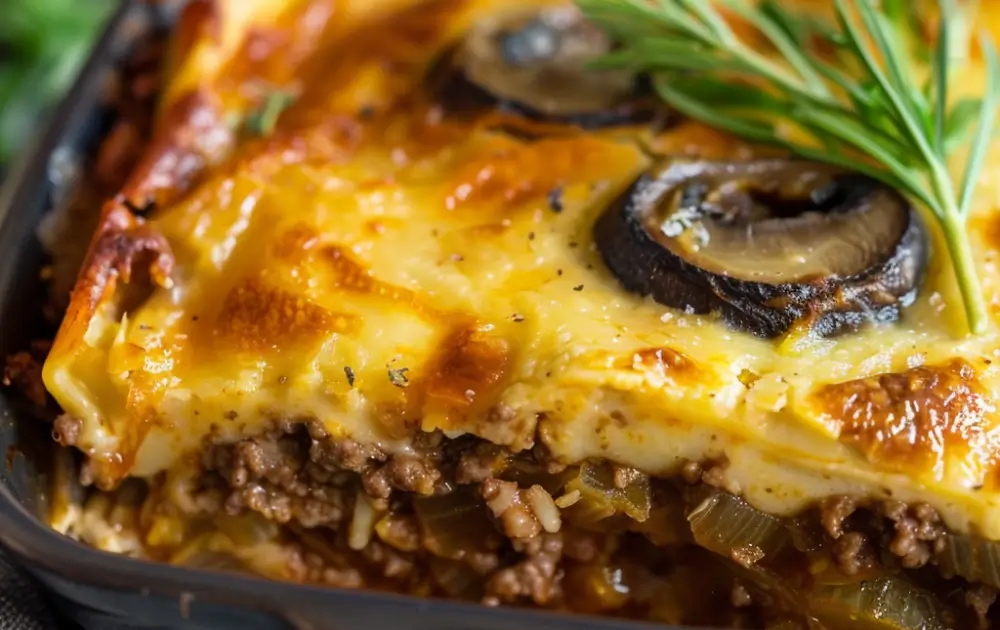Authentic Greek Moussaka Recipe – Rich and Comforting
Greek Moussaka is a beloved traditional dish that stands as a pillar of Mediterranean cuisine. This layered casserole combines slices of eggplant and potatoes with a rich, savory meat sauce, all topped with a creamy béchamel sauce and baked to perfection. Its complex flavors and textures make Moussaka a comforting and satisfying meal, embodying the warmth and richness of Greek cooking.
Selecting the Right Ingredients
For an authentic Moussaka, choosing the right ingredients is crucial. Fresh eggplants and potatoes form the vegetable base, while the meat sauce typically features ground lamb or beef, cooked with onions, garlic, and a blend of spices including cinnamon, nutmeg, and allspice. The béchamel sauce, a key component, requires butter, flour, milk, and a touch of nutmeg, enriched with egg yolks for added creaminess.
Preparing the Vegetables
The first step in making Moussaka is preparing the vegetables. Slice the eggplants and potatoes into thin rounds, then either fry them or roast them until they are tender and slightly browned. This not only enhances their flavor but also prevents the casserole from becoming too watery. Draining the slices on paper towels helps to remove excess oil.
Crafting the Meat Sauce
The heart of Moussaka lies in its meat sauce. Begin by sautéing onions and garlic until they are soft and fragrant. Add the ground meat, breaking it apart with a spoon as it cooks. Once the meat is browned, incorporate the tomatoes and spices, letting the mixture simmer until it thickens. This creates a rich, flavorful sauce that is the soul of the dish.
Layering the Moussaka
Assembling Moussaka is an art that involves careful layering. Start with a layer of potatoes at the bottom of a greased baking dish, followed by a layer of eggplant slices. Spread a generous amount of meat sauce over the eggplant, then repeat the layering process until all ingredients are used, finishing with a layer of eggplant.
Making the Béchamel Sauce
The béchamel sauce is what sets Moussaka apart, giving it a luxurious finish. Melt butter in a saucepan, whisk in flour to form a roux, then gradually add milk while stirring continuously to prevent lumps. Once the sauce thickens, remove it from the heat and stir in the egg yolks and cheese, seasoning with salt, pepper, and nutmeg. Pour the béchamel over the final layer of eggplant, spreading it evenly to cover.
Baking to Perfection
Bake the Moussaka in a preheated oven until the top is golden and bubbly, a process that melds the flavors and textures into a harmonious whole. Letting the Moussaka rest for a few minutes before serving allows it to set, making it easier to cut into portions.
Serving and Enjoyment
Moussaka is traditionally served warm, not hot, to appreciate its depth of flavor fully. Accompanied by a simple salad and a glass of red wine, it offers a complete and hearty meal. Each bite of Moussaka is a testament to the rich culinary heritage of Greece, inviting you to explore the layers of its history and tradition through taste.
Mastering the Béchamel Sauce
The béchamel sauce is a critical element that crowns the Moussaka, providing a creamy, rich layer that complements the robust flavors beneath. Achieving the perfect béchamel requires patience and attention to detail. Stirring constantly to avoid lumps and cooking on a low heat to prevent burning are key steps. For those looking to enrich the sauce further, incorporating a pinch of ground clove or bay leaf can add subtle depth to its flavor profile.
Tips for a Perfectly Layered Moussaka
Creating beautifully defined layers in Moussaka not only enhances its visual appeal but also ensures an even distribution of flavors and textures. To achieve this, ensure that each layer of eggplant and potatoes is evenly sliced and thoroughly cooked before assembly. Pressing down gently on each layer as you build the Moussaka helps to compact the ingredients, resulting in a more cohesive dish that’s easier to serve.
Innovative Moussaka Presentations
While traditionally served in a large baking dish, Moussaka can also be prepared in individual ramekins or cast-iron skillets for a personalized touch. This approach not only makes for an elegant presentation but also allows for customization of portions, catering to individual preferences or dietary restrictions. Additionally, garnishing with fresh herbs or a sprinkle of paprika before serving can add color and enhance the dish’s visual appeal.
The Role of Moussaka in Mediterranean Cuisine
Moussaka is a testament to the richness and diversity of Mediterranean cuisine. Its layers symbolize the blending of various culinary traditions and influences, from the Ottoman Empire to the tavernas of modern Greece. Moussaka’s enduring popularity underscores the Mediterranean commitment to fresh ingredients, bold flavors, and communal eating, celebrating a culture where food is much more than sustenance—it’s a way of life.
Embracing the Complexity of Flavors
The complexity of Moussaka’s flavors is what makes it a standout dish. The sweetness of the roasted vegetables, the savory depth of the meat sauce, and the creamy tang of the béchamel come together in a symphony of taste. Understanding how these elements interact and complement each other is key to mastering Moussaka. Experimenting with spices, adjusting seasoning, and balancing the richness of the sauce with the other components allows cooks to tailor the dish to their palate, making each Moussaka unique.
Preserving and Storing Leftover Moussaka
Moussaka is one of those dishes that can taste even better the next day, as the flavors have more time to meld together. To properly store leftover Moussaka, allow it to cool to room temperature before covering it tightly with plastic wrap or transferring it to an airtight container. It can be refrigerated for up to three days. When ready to enjoy again, reheat portions in the oven or microwave until thoroughly warmed. For longer storage, Moussaka can be frozen and enjoyed at a later date, ensuring a taste of Mediterranean warmth any time of year.
Sustainable Cooking with Moussaka
Incorporating principles of sustainability into cooking Moussaka can start with sourcing ingredients. Opting for locally grown vegetables and ethically sourced meats not only supports local economies but also reduces the carbon footprint associated with food transportation. Additionally, using every part of the ingredients, such as repurposing vegetable peels for stock, emphasizes a no-waste approach in the kitchen, aligning with sustainable cooking practices.
The Nutritional Profile of Moussaka
While indulgent, Moussaka can fit into a balanced diet with its array of nutrients. Eggplants offer dietary fiber, vitamins, and minerals, while the potatoes provide a good source of vitamin C and potassium. The meat sauce contributes protein, making Moussaka a hearty and nutritious option. For those monitoring their intake, variations in the recipe can adjust the calorie and fat content without sacrificing the dish’s comforting essence.
Moussaka as a Culinary Learning Experience
Preparing Moussaka offers a culinary learning experience, from mastering the technique of making a smooth béchamel sauce to understanding how to layer ingredients for optimal flavor and texture. It encourages cooks to experiment with spices, explore the balance of flavors, and develop patience and precision in the kitchen. Each step in the process, from selecting ingredients to the final bake, is an opportunity to enhance one’s cooking skills and appreciation for Greek cuisine.
Celebrating Cultural Heritage Through Moussaka
Moussaka is more than just a meal; it’s a celebration of Greek cultural heritage. Through its layers, it tells a story of history, tradition, and the importance of food in bringing people together. Cooking and sharing Moussaka is a way to connect with Greek culture, offering a delicious insight into the country’s rich culinary landscape. Whether enjoyed at a family gathering or a casual dinner with friends, Moussaka serves as a reminder of the power of food to transcend borders and foster connections.
Adapting Moussaka for Various Dietary Needs
Moussaka’s traditional recipe is adaptable to meet various dietary needs, making it accessible to a wider audience. For a vegetarian version, lentils or chickpeas can replace the ground meat, offering a protein-rich alternative that maintains the dish’s hearty texture. Gluten-free adaptations involve substituting all-purpose flour with a gluten-free blend for the béchamel sauce. Dairy-free versions can be achieved by using plant-based milk and cheese, ensuring everyone can enjoy this classic dish regardless of dietary restrictions.
The Art of Balancing Moussaka’s Flavors
Achieving the right balance of flavors in Moussaka is crucial for a harmonious dish. The sweetness of the roasted eggplant pairs beautifully with the savory meat sauce, while the creamy béchamel adds a rich counterpoint. Adjusting the seasoning in each layer, from the pinch of cinnamon in the meat to the nutmeg in the béchamel, is key to creating a well-rounded flavor profile. Taste testing at each stage of preparation ensures the final dish is perfectly balanced.
Pairing Moussaka with the Perfect Side Dishes
While Moussaka is a filling dish on its own, pairing it with the right side dishes can elevate the meal. A simple Greek salad, dressed with olive oil and lemon juice, adds a refreshing contrast to Moussaka’s richness. For a heartier accompaniment, consider serving it with a side of roasted Mediterranean vegetables or a dish of warm, crusty bread for dipping into the béchamel sauce. These pairings enhance the dining experience, bringing a touch of Greek taverna to your table.
Exploring the Regional Variations of Moussaka
Not only in Greece but also across the Balkans and the Middle East, people celebrate Moussaka, with each region offering its unique take on the dish. In some areas, cooks replace the eggplant with potatoes or introduce additional layers of meat. Other variations include the addition of béchamel sauce infused with local cheeses or spices, reflecting the diverse culinary traditions of each region. Exploring these variations provides a deeper understanding of Moussaka’s versatility and its role in different cultures.
Moussaka: A Dish for All Seasons
FAQs About Moussaka
Can I make Moussaka ahead of time? Yes, you can prepare Moussaka ahead of time. Assemble the dish, cover it, and refrigerate for up to 24 hours before baking. You may need to add a few extra minutes to the baking time if it’s coming straight from the refrigerator.
Is Moussaka freezer-friendly? Moussaka freezes exceptionally well. Cool the cooked Moussaka completely, then cover it tightly with foil or transfer it to an airtight container. It can be frozen for up to 3 months. Thaw in the refrigerator overnight and reheat in the oven.
How can I prevent my Moussaka from being watery? To prevent Moussaka from becoming watery, ensure that the eggplant and potatoes are well-drained after cooking. Additionally, letting the meat sauce thicken properly during cooking will help minimize excess moisture.
What’s the best way to slice Moussaka? For clean slices, let the Moussaka rest for 20-30 minutes after baking. Use a sharp knife and clean it between slices to ensure neat portions.
Can I use a different type of meat for the Moussaka? Absolutely. While ground lamb is traditional, ground beef, pork, or a mixture can also be used. For a vegetarian option, lentils or a meat substitute work well.
Conclusion
Moussaka is a rich, layered dish that captures the essence of Greek cuisine, offering a symphony of flavors and textures in every bite. From the silky eggplants and tender potatoes to the aromatic meat sauce topped with a golden béchamel, Moussaka is a testament to the depth and diversity of Mediterranean cooking. Whether you stick to the traditional recipe or explore variations to suit dietary needs and personal tastes, Moussaka remains a beloved dish that brings people together. Its versatility, combined with the ability to make it ahead and freeze for later, makes Moussaka a practical and satisfying option for any meal. Dive into the art of making Moussaka, and enjoy a piece of Greek culinary heritage right at your table.

Greek Moussaka
- Total Time: 2 hours 15 minutes
- Yield: 8 servings
Description
Greek Moussaka is a classic Mediterranean casserole that layers eggplant, potatoes, a savory meat sauce, and is topped with a creamy béchamel. This rich and comforting dish is a staple of Greek cuisine, known for its depth of flavor and satisfying texture.
Ingredients
Instructions
Notes
- Draining the eggplant reduces bitterness and excess moisture.
- The béchamel sauce should be smooth and creamy; ensure it’s free of lumps by whisking well.
- Allowing the Moussaka to rest before serving helps the layers set for easier slicing.
- Prep Time: 1 hour
- Cook Time: 1 hour 15 minutes
- Category: Main Course
- Method: Baking
- Cuisine: Greek
Nutrition
- Calories: 550
- Fat: 35g
- Carbohydrates: 35g
- Fiber: 6g
- Protein: 25g




